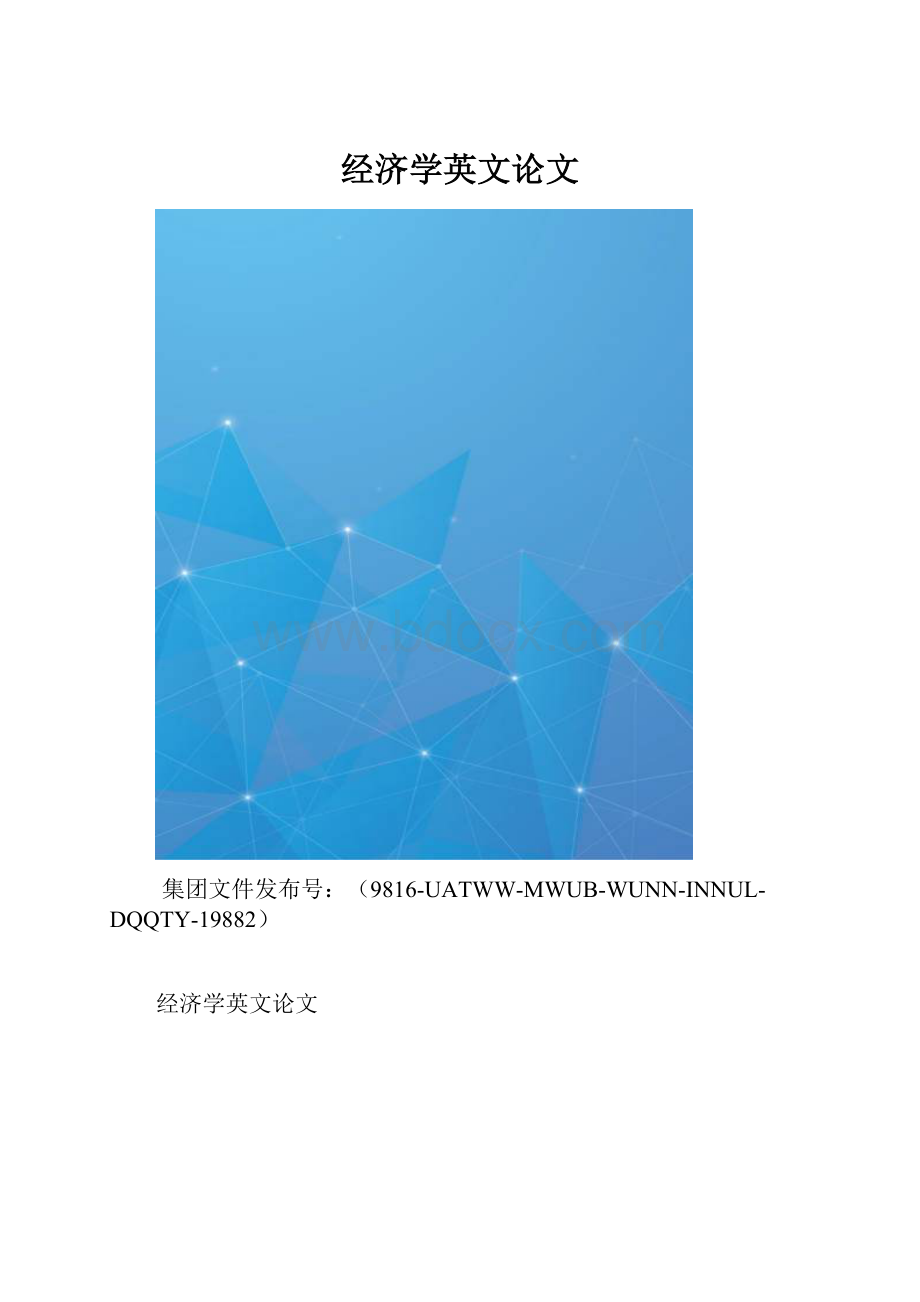经济学英文论文.docx
《经济学英文论文.docx》由会员分享,可在线阅读,更多相关《经济学英文论文.docx(7页珍藏版)》请在冰豆网上搜索。

经济学英文论文
集团文件发布号:
(9816-UATWW-MWUB-WUNN-INNUL-DQQTY-19882)
经济学英文论文
Aqualitativestudyofbusiness-to-businesselectroniccommerceadoptionwithintheIndonesiangroceryindustry:
Amulti-theoryperspective
Abstract
Thisstudyexploresthebusiness-to-businesselectroniccommerce(B2BEC)technologyadoptionexperienceoforganizationswithinthesupplychainofthegroceryindustryinIndonesiausingamulti-theoryperspective.Throughamultiplecasestudywitheightorganizations,itprovidesacomprehensiveunderstandingoftheinfluenceofadoptionfactors.Thisstudyshowstheusefulnessofcomplementarilydeployingseveraladoptiontheoriesandoffersimportanttheoreticalandpracticalimplicationsfororganizationsastheyextendtheirsupplychainsglobally.
Keywords
Electroniccommerce;?
Technologyadoption;?
Groceryindustry;?
Developingcountry;?
Supplychainmanagement;?
Qualitativestudy
1.Introduction
ElectronicCommerce(EC)isabroadconceptthatreferstotheexchangeofproducts/servicesandinformationviacomputernetworks,includingtheInternet,ExtranetandIntranet?
.WithintheB2BECcontext,adiverserangeoftechnologiesandinitiativeshavebeenintroduced.ExamplesoftechnologiesincludeElectronicDataInterchange(EDI),automaticproductidentification(barcode,RFIDtags),andElectronicFundsTransfer,andexamplesofinitiativesincludecrossdocking,VendorManagedInventory(VMI),ContinuousReplenishmentProgram(CPR),andCollaborativePlanning,ForecastingandReplenishment(CPFR)?
.OrganizationscanobtainsubstantialbenefitsfromtheirinvestmentinECtechnologies,asECgenerallyenablesorganizationstoimprove?
reach,?
richness?
and?
affiliation?
.DuetothepotentialofEC,manycountriesworldwidehaverapidlyadoptedit?
resultinginasignificantgrowthofECindevelopedcountriesduringthelasttwodecadesand,morerecently,indevelopingcountries?
.
Intheeraofglobalization,developingcountrieshaveplayedanimportantroleinworldtradeandcommercebecauseoftheirlargemarketpotentialandlowcostoflabor?
.Developingcountriesaredefinedascountrieswithalowtomiddleincomelevel,alowstandardofliving,restrictedtechnologyinfrastructureandlimitedaccesstoproductsandservices?
.Withadvancementsininformationandcommunicationtechnologies(ICT),largeglobalorganizationsareincreasinglyextendingtheirsupplychainsacrossmultiplecontinentsinordertocutcostsandincreasetheirreach?
.ThroughICTadoption,developedcountriescantradewithdevelopingcountriesmoreefficientlyand,inturn,helpthosedevelopingcountriesachievemoresustainableeconomicgrowth.
However,duetodifferencesintheirsocial,cultural,economic,political,legalandtechnologicalconditions,developingcountriesencounterasetofproblemsandconcernsthatvaryconsiderablyfromthosefacedbydevelopedcountries?
Forexample,Hofstede'snationalculturetheorysuggeststhatdevelopingcountriesanddevelopedcountriesdiffergreatlyintheircharacteristics,whichmayaffecttheirorganizationalbehaviortowardtechnologyadoption?
.CulturaldifferencescapturedbyPowerDistanceandUncertaintyAvoidancedimensionssuggestthatorganizationaltechnologyadoptionbehaviorisconstrainedsociallyasaresultoftheattachmentofmeaningsandinterpretationsrelevanttothatculturalcontext.Thus,organizationsoperatingindevelopedcountries(withalowUncertaintyAvoidanceindex)tendtostressbothtechnologicaldevelopmentandtechnologicaladoptionmorethanorganizationsoperatingincountrieswithahighPowerDistanceandlowtoleranceforambiguityanduncertainty?
.Inanotherstudy,Guoetal.?
findthatthewayorganizationsusee-mail,phoneandfaxinChina(adevelopingcountry)andAustralia(adevelopedcountry)islargelyinfluencedbythedifferenceintheUncertaintyAvoidancedimensionofculturaldifferencebetweenthesetwonations.Asaresult,differentsetsofapproachestotechnologyadoptionarerequiredtosuittheculturalandcontextualconditionsofdevelopingcountries?
.
However,atthisstage,thereremainsarelativelylimitednumberofin-depthstudiesandunderstandingregardingtheadoptionofECtechnologiesbydevelopingcountries,despiteagrowingnumberoftechnologypenetrationsthathavetakenplaceinthesecountriesinrecentyears?
AnunderstandingoftheadoptionofICT,inparticularECtechnology,bydevelopingcountriesisthusimportantforbothresearchersandpractitioners.Moreover,thecontextualsituationsofcountriesarearguablydifferentinnature.Forexample,thematurityoftheICTinfrastructure,e-commercereadiness,degreeofgovernmentsupport,andextentofbusinesscompetitivenessvarygreatly,notonlybetweenthedevelopedanddevelopingcountriesbutalsoamongdevelopingcountries.Furthermore,itwouldbeinappropriatetoassumethatvariousdimensionsofnationalcultureremainsomewhatsimilaracrossalldevelopingcountries.Infact,distinctculturaldifferencesarenotedamongdevelopingcountries.Hence,itcouldbearguedthatqualitativestudiesfocusingone-commerceadoptioninsomedevelopingcountriesarenotnecessarilyreflectiveofthee-commercetrendsandadoptiondynamicsofalldevelopingcountriesacrosstheglobe.
Inaddition,somenoticeablegapshavebeenidentifiedintheexistingECliterature.First,inthecontextofdevelopingcountries,therearelimitedempiricalstudiesonECtechnologyadoptionbylargeorganizations.Bycontrast,manystudiesexplorethediffusionofECtechnologiesamongsmallandmedium-sizedenterprises(SMEs),primarilyusingsurveys.Second,mostofthesestudies,especiallyintheSoutheastAsiaregion,exploreonlygeneralECtechnologyandpractices(includingBusiness-to-CustomersECandgenerale-mailpractices).OnlyahandfulofstudiesassessabroadrangeofECtechnologiessuchasEDI,e-auctions,EFT,andotherB2BECinitiatives?
.Furthermore,duetotheexclusionofthestudycontext,therehavebeensomeconflictingfindingsregardingtheimpactofadoptionfactorsonactualadoption?
.Inaddition,severalexistingstudiesaggregatetheadoptionexperienceacrossmultipleindustrieswithinacountryusingquantitativemethods.Therefore,adetailedunderstandingoforganizations’adoptionexperienceislacking?
.Onlyafewauthorsfocusonaspecificindustryandemployaqualitativemethod,forexample,UtomoandDodgson?
whoconcentrateonIndonesia'smanufacturingofindustrialproducts,andKurnia?
whofocusesontheChinesegroceryindustry.TheexistingqualitativestudiesonECadoptionarealsogenerallydescriptiveinnature.Typically,theyidentifyanumberofadoptionfactors,whichareoftengroupedintotechnological,organizationalandenvironmentalcontextsbutgenerallylacktheoreticalexplanationsoftheunderlyingmechanismsoftheinfluence.
Thus,insummary,wearguethatthereiscurrentlyalackofrichunderstandingoftheB2BECadoptionphenomenonindevelopingcountriesduetothedominanceofquantitativestudiesandthelimitedapplicationofadoptiontheories?
.Infact,theadoptionprocessinvolvesdynamicinteractionsamongsocial,legal,economic,politicalandtechnologicalfactorsthatcallformorestudiesinvolvingseveraltheoreticalperspectivestobetterunderstandtheadoptionphenomenonindifferentcontextsofdevelopingcountries.Eachdevelopingcountrymayhavespecificcontextualfactorsinvolvingdifferentdynamicsandinterplays,whichmayhavedifferingeffectsontheadoptionphenomenon.In-depthstudiesofhowB2BECtechnologyisadoptedinacontextthathasnotyetbeenthoroughlyinvestigatedthuscontributetothecurrentknowledgeinthisarea.
2.OverviewoftheIndonesiangroceryindustry
Indonesiahasmanynaturalresources,anditseconomicpositionhasdevelopedrapidly.TheIndonesianeconomyisranked16th?
onaglobalscalebasedonGDP,anditspurchasingpowerisranked15th.Indonesiahasbeenanimportanttradingpartnerformanycountries,includingChina,India,Australiaandmanyotherdevelopednations?
.Inparticular,foreignretailersquitenaturallyseektodevelopapresenceinanycountrywithalargepopulationbase.Inaddition,givenyearsofcontinuousimpressiveandsustainedeconomicgrowthinIndonesiaduringthe1990s,thegroceryindustrypresentedtremendouspotentialforfuturegrowthintheeyesofforeignretailers?
.
StronggrowthinIndonesians’personaldisposableincomehasledtosteadyescalationingroceryretailsalessincetheendofthe20thcentury.Thisreflectsasubstantialincreaseintheminimumwage,highinflationrates,andrecoveryfromthe1998crisis.Indonesiaisviewedasamarketthatiscloselyassociatedwithcontinuouseconomicrecoveryandsteadyadoptionofconsumerism.In2002,retailsalesinIndonesiaamountedtonearlyUS$7billion,andthesectoremployedapproximately17.7%ofIndonesian'stotallabor.In2012,groceryretailsalesinIndonesiaamountedtoapproximatelyUS$36billionandareestimatedtoincreasetoUS$64billionby2016?
.ThesefiguresshowthepotentialimpactofthegroceryindustryonIndonesia'soveralleconomicsituationforyearstocome.
ThecurrentIndonesiangroceryretailmarketcanbedividedintothetraditionalmarketformat,whichincludestraditionalstoresandwetmarkets,andthemodernmarketformat,whichincludesminimarkets(conveniencestores),supermarkets,andhypermarkets.Inurbanareas,thehighconcentrationofdifferentretailtypeshasintensifiedcompetition.Hypermarkets,withtheirlargeproductofferingsofapproximately60,000items,arestronglycompetingwithsupermarketsformarketshare,andbothareintightcompetitionwiththetraditionalmarketformat.Thetraditional